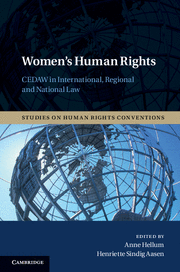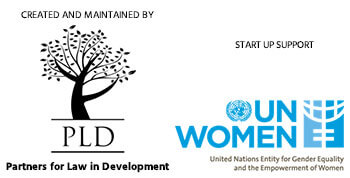There are three foundational principles of the CEDAW Convention. These are non-discrimination, substantive equality, and state obligation. These are considered to be the three pillars on which the implementation of CEDAW rests.
Read More
Non Discrimination
Non-discrimination is integral to the concept of equality. The Convention adopts a broad understanding of non-discrimination that seeks to eliminate discrimination against all women in all fields (social, political, economic, cultural, civil or any other) and spheres (public and private), and holds both state and non-state actors accountable in the case of any violation of rights. Article 1 of CEDAW provides a comprehensive definition of discrimination:
“Any act of distinction, exclusion or restriction which has the intent / purpose or effect of nullifying, impairing or denying the enjoyment of rights by women.” The definition of discrimination outlined in CEDAW goes beyond the mere acts of discrimination and addresses the roots from where it emanates, that is, the gender-based ideology that stereotypes the roles of men and women and that results in women’s subordination. Therefore, Article 5(a) of CEDAW obliges state parties to undertake appropriate measures to “modify social and cultural patterns of conduct of men and women” to eliminate prejudice and customary and other practices that are “based on the idea of [the] inferiority or the superiority of either of the sexes or stereotyped roles of men and women.”
Discrimination can be direct or indirect and intended or unintended. Direct discrimination is that which has the intention of discriminating. Indirect discrimination any unintended action or inaction that has the effect of denying a person the exercise of a right. Under CEDAW, for example, discrimination is said to have occurred when an apparently neutral condition or requirement that ignores barriers obstructing women’s participation is imposed. The condition’s effect would perpetuate, though unintentionally discrimination against women. The focus, therefore, is on outcomes and results, or on the transformation of the de facto inequality of women.
Discrimination may be current, cross-cutting, or historic. Historic discrimination occurs when a group suffers from the effect of past discrimination, or when discriminatory treatment further oppresses a group that has historically experienced institutional or systematic oppression. The Convention recognizes that equal treatment of women and men is not sufficient for transforming or improving the situation of women.
CEDAW promotes affirmative action, which is based on the principle that equality should be achieved in both law and practice. It is not sufficient to merely recognize the principle of universal equality, but positive measures should also be taken to ensure the realization of genuine de facto equality, in other words, equality of outcomes and equality of effects. This is premised on the idea that non-discrimination does not mean identical treatment in every instance.
You can access the CEDAW Quick & Concise video explaining the principle of non-discrimination here.
Users who cannot access YouTube can view the video here.
For a list of readings and articles on non-discrimination, please see the Resource section.
Read More
Substantive Equality
There have been two main approaches to gender equality—the sameness approach and the difference approach. The sameness approach, also known as the formal approach, treats women the same as men. It believes that differing treatment for men and women amounts to an admission of the negative stereotypes attached to women, reinforcing patriarchal hierarchy. Its principal aim is to achieve ‘equal treatment’ rather than equality of outcomes. In failing to recognize gender difference, the sameness approach perpetuates the unequal status of women in the long run.
The difference approach of equality recognizes that men and women have different lived realities and occupy different social spaces. The rationale for and response to this difference, however, may vary resulting in two approaches based on the difference model of equality. Of these, the protectionist approach accepts the differences between men and women in society as natural and inherent to the two sexes, and therefore not needing the same treatment. This approach views biological difference and social assumptions as standards for the roles and capacities attached to men and women. According to this approach, biological difference justifies differential treatment of men and women. This approach is problematic for its rationalization and treatment of difference; it accepts the difference as a natural phenomenon, thus sanctioning the treatment and status of women.
The Convention promotes the corrective or substantive equality approach. It acknowledges gender differences as products of negative female stereotypes, and consequently seeks to eliminate discrimination at the individual, institutional, and systemic levels through corrective and positive measures including enabling conditions and affirmative action. Its principal concern is to ensure that the law corrects the imbalance and has a positive impact on the outcome by assuring equal opportunities, access, and benefits for women. In doing so, it seeks a paradigm shift from ‘equal treatment’ or merely ‘different treatment’ to ‘equality of outcomes’. Substantive equality under the Convention requires the state to put in place laws, policies, and measures, including through affirmative action, to improve the status of women.
The Convention imposes an obligation on the state parties to adopt temporary special measures to accelerate the achievement of equality of opportunity for both men and women with a view to achieving women’s de jure and de facto equality with men in the enjoyment of their human rights and fundamental freedoms. These can be in the form of temporary special measures that address the special needs of women.
Please see General Comment 25 on Temporary Special Measures here.
You can access the CEDAW Quick & Concise video explaining the principle of substantive equality here.
Users who cannot access YouTube can view the video here.
Read More
State Obligation
State obligation is an integral part of the framework defining non-discrimination and equality. State obligation under CEDAW embodies four important elements, that is, respect, protection, promotion, and fulfilment of human rights. The Preamble and Articles 2–4 of the Convention spell out the binding nature of the treaty and describe the ambit of state obligation. An important aspect of the state’s obligation is the concept of due diligence, which demands ensuring the prevention, investigation, and sanctioning of private acts of discrimination. The responsibility for the fulfilment of all state obligations is divided among the three organs of the state—legislature, executive, and judiciary.
State obligation has two interrelated aspects: (1) implementing and incorporating CEDAW standards and norms within the sphere of domestic jurisdiction; and (2) reporting to the UN treaty body about progress in the realization of CEDAW at the domestic level, as well as related challenges. Accordingly, every state party submits initial and periodic reports to the treaty body in respect to the fulfilment of CEDAW. Initial reports are submitted within a year, while periodic reports are submitted once every four years. These reports highlight the actualization of women’s human rights, identify the obstacles faced and overcome, and describe the action taken to promote, protect, and fulfil women’s rights. The periodic reporting process builds a culture of accountability among the state parties centred on the need to provide specific details of policies, programme, and initiatives taken to eliminate gender and other forms of intersectional discrimination against women.
Article 2 (a) specifically observes that state parties undertake to:
“embody the principle of the equality of men and women in their national constitutions or other appropriate legislation if not yet incorporated therein and to ensure, through law and other appropriate means, the practical realization of this principle.”
This includes creating an enabling environment or conditions that enable de facto equality. These conditions could be in the form of temporary special measures aimed at achieving equality by addressing historical discrimination, such as setting up crèches for children and introducing reservation of seats for women. They should be seen as positive steps necessary for achieving equality for a group that has been historically discriminated against. Measures can also be continuing and on-going in nature, such as those relating to maternity.
Article 2 (e) obliges state parties to take all appropriate measures to eliminate discrimination against women by any person, organization, or enterprise. The state can ensure the promotion of human rights through its programmes that are aimed at generating awareness of various rights, or through its policies that guarantee minimum representation of women in all fields.
You can access the CEDAW Quick & Concise video explaining the principle of state obligation here.
Users who cannot access YouTube can view the video here.
For List of Countries who have ratified CEDAW click here.











